Le script ci-dessous propose de remplacer a distance le contenu du fichier de resolution c:\windows\system32\etc\hosts et d'effectuer un test de resolution des nouveaux noms.
Remote_ModifyHostFiles_And_Test.ps1 (3,61 kb)
# SCRIPT TO MODIFY HOSTS FILE ON TARGET SERVER AND REMOTELY TEST RESOLUTION
Param(
$SrvList = ("Srv1","Srv2"),
$HostFilePath = "C:\Windows\System32\drivers\etc\hosts",
$cred = $(Get-Credential -Credential MyDomain\Me),
$Host1 = "Host1",
$IP1 = "0.0.0.1",
$Host2 = "Host2",
$IP2 = "0.0.0.2"
)
$cred = $(Get-Credential -Credential MyDomain\Me)
# host file
$hostcontent =
"# Copyright (c) 1993-2009 Microsoft Corp.
#
# This is a sample HOSTS file used by Microsoft TCP/IP for Windows.
#
# This file contains the mappings of IP addresses to host names. Each
# entry should be kept on an individual line. The IP address should
# be placed in the first column followed by the corresponding host name.
# The IP address and the host name should be separated by at least one
# space.
#
# Additionally, comments (such as these) may be inserted on individual
# lines or following the machine name denoted by a '#' symbol.
#
# For example:
#
# 102.54.94.97 rhino.acme.com # source server
# 38.25.63.10 x.acme.com # x client host
# localhost name resolution is handled within DNS itself.
# 127.0.0.1 localhost
# ::1 localhost
# MY SERVERS
$Host1 $IP1
$Host2 $IP2
"
# FUNCTIONS
function Spec-Ping
{
Param($HostToPing)
Try {
Test-Connection -ComputerName $HostToPing -Count 1 -ErrorAction Stop
}
Catch [System.Net.NetworkInformation.PingException]
{
$pingresult = "PING ERROR TO $HostToPing - CHECK NAME RESOLVING"
}
}
# OPENING WINRM SESSIONS ON MGS SERVERS
$SrvList | foreach {
try
{
New-PSSession -Name $($_.Substring(0,13)) -ComputerName $_ -Credential $cred
}
catch
{
write-host -F red "Erreur lors de la creation de la session Winrm vers $_"
}
}
$sessions = Get-PSSession
Foreach ($sess in $sessions)
{
Invoke-Command -Session $sess -ScriptBlock {Param($hostcontent,$HostFilePath) Set-Content -Path $HostFilePath -value $hostcontent} -ArgumentList $hostcontent,$HostFilePath
}
Write-Host "`n--- PING RESULT:"
Foreach ($sess in $sessions)
{
# First Host Test
$pingresult = Invoke-Command -Session $sess -ScriptBlock ${Function:Spec-Ping} -ArgumentList $Host1
switch -Wildcard ($pingresult.value)
{
"PING ERROR*" {write-host -ForegroundColor red $pingresult.value}
}
Switch ($pingresult.IPV4Address.IPAddressToString)
{
$IP1 {Write-Host "OK -- $Host1 is resolved by "$sess.ComputerName" to $IP1"}
default {Write-Host "KO - Unable to get resolution of $Host1 on"$sess.ComputerName""}
}
# Second Host Test
$pingresult = Invoke-Command -Session $sess -ScriptBlock ${Function:Spec-Ping} -ArgumentList $Host2
switch -Wildcard ($pingresult.value)
{
"PING ERROR*" {write-host -ForegroundColor red $pingresult.value}
}
Switch ($pingresult.IPV4Address.IPAddressToString)
{
$IP2 {Write-Host "OK -- $Host2 is resolved by "$sess.ComputerName" to $IP2"}
default {Write-Host "KO - Unable to get resolution of $Host2 on"$sess.ComputerName""}
}
}
#Remove Pssessions
Remove-PSSession *
L'idée du script ci-dessous est de proposer une forme d'inventaire des applications couvertes par une infra SCOM, en utilisant une liste, a maintenir, des principales classes d'objets tel que 'Active Directory Domain Controller Computer Role' ou encore 'IIS Server Role'.
Il est donc necessaire de maintenir un minimum dans le temps, le contenu de $ClassList, et la correspondance faites entre les pattern de nom de classes et les application correspondantes.
SCOM_Inventory_with_Main_Classes.ps1 (12,71 kb)
### SCOM INVENTORY USING APPLICATION MAIN CLASS ###
#Parameters
Param(
$MS= "MyMS.MyDomain",
$cred = $(Get-Credential "MyDomain\")
)
# List of all 'Top' Classes for which we need to get instances
$ClassList=(
# ACTIVE DIRECTORY
'Active Directory Domain Controller Computer Role',` # ACTIVE DIRECTORY
'Certificate Service', # ACTIVE DIRECTORY CERTIFICATE SERVICES
'Federation Server', # ACTIVE DIRECTORY FEDERATION SERVICES
# CITRIX
'Managed Citrix Presentation Server', # CITRIX
# EXCHANGE
'Microsoft Exchange 2010 Server', # EXCHANGE
'Exchange 2007 Server Role', # EXCHANGE
'Exchange 2013 Server', # EXCHANGE
# LYNC/SKYPE
'LS Server Role', # LYNC/SKYPE
# SHAREPOINT
'SharePoint Server', # SHAREPOINT
# SQL
'SQL Server 2008 DB Engine', # SQL (SQL 2008)
'SQL Server 2012 DB Engine', # SQL (SQL 2012)
'SQL Server 2014 DB Engine', # SQL (SQL 2014)
'SQL Server 2016 DB Engine', # SQL (SQL 2016)
'MSSQL on Windows: DB Engine', # SQL (SQL 2017+)
# SQL SSIS
'SQL Server 2014 Integration Services', # SQL SSIS (SQL 2014)
'SQL Server 2016 Integration Services', # SQL SSIS (SQL 2016)
'MSSQL on Windows Integration Services: Local Instance', # SQL SSIS (SQL 2017+)
# SQL SSAS
'SSAS 2008 Instance', # SQL SSAS (SQL 2008)
'SSAS 2012 Instance', # SQL SSAS (SQL 2012)
'SSAS 2014 Instance', # SQL SSAS (SQL 2014)
'SSAS 2016 Instance', # SQL SSAS (SQL 2016)
'MSSQL Analysis Services: Generic Instance', # SQL SSAS (SQL 2017+)
# SQL SSRS
'Microsoft SQL Server 2008 Reporting Services (Native Mode)', # SQL SSRS (SQL 2008)
'Microsoft SQL Server 2012 Reporting Services (Native Mode)', # SQL SSRS (SQL 2012)
'Microsoft SQL Server 2014 Reporting Services (Native Mode)', # SQL SSRS (SQL 2014)
'Microsoft SQL Server 2016 Reporting Services (Native Mode)', # SQL SSRS (SQL 2016)
'MSSQL Reporting Services: Instance (Native Mode)' , # SQL SSRS (SQL 2017)
# WINDOWS CLUSTER NODES
'Cluster Node', # WINDOWS CLUSTER
# IIS
'IIS Server Role', # IIS
# WINDOWS PRINT SERVER
'Print Services Role', # WINDOWS PRINT SERVER
# WINDOWS DNS
'Windows DNS Server', # WINDOWS DNS
# WSUS
'WSUS 3.0 Server', # WSUS
'Microsoft Windows Server Update Services 2012 R2', # WSUS
'Microsoft Windows Server Update Services 2016' # WSUS
)
#Import of SCOM module
try
{
Import-Module -Name OperationsManager -ErrorAction stop
}
catch
{
write-host -ForegroundColor red "Error during import of SCOM Module"
}
#Connection to $MS management server
New-SCOMManagementGroupConnection -ComputerName $MS -Credential $cred
# Create an empty tableau
$Finaltableau = @()
# Get All Instances for each class
foreach ($classname in $ClassList)
{
$class = Get-SCOMClass -DisplayName $classname
# If class is found we can go on
If($class)
{
$instances += Get-SCOMClassInstance -Class $class -ErrorAction SilentlyContinue
foreach ($inst in $instances)
{
$obj = New-Object psobject
switch -Regex ($classname)
{
# ACTIVE DIRECTORY
"Active Directory Domain Controller Computer Role"
{
$obj | Add-Member -Name "COMPUTER" -membertype Noteproperty -Value $inst.path
$obj | Add-Member -Name "CLASS" -membertype Noteproperty -Value $classname
$obj | Add-Member -Name "MAIN ROLE" -membertype Noteproperty -Value "ACTIVE DIRECTORY"
}
# ACTIVE DIRECTORY CERTIFICATE SERVICES
"Certificate Service"
{
$obj | Add-Member -Name "COMPUTER" -membertype Noteproperty -Value $inst.displayname
$obj | Add-Member -Name "CLASS" -membertype Noteproperty -Value $classname
$obj | Add-Member -Name "MAIN ROLE" -membertype Noteproperty -Value "ACTIVE DIRECTORY CERTIFICATE SERVICES"
}
# ACTIVE DIRECTORY FEDERATION SERVICES
"Federation Server"
{
$obj | Add-Member -Name "COMPUTER" -membertype Noteproperty -Value $inst.displayname
$obj | Add-Member -Name "CLASS" -membertype Noteproperty -Value $classname
$obj | Add-Member -Name "MAIN ROLE" -membertype Noteproperty -Value "ACTIVE DIRECTORY FEDERATION SERVICES"
}
# CITRIX
".*Citrix.*"
{
$obj | Add-Member -Name "COMPUTER" -membertype Noteproperty -Value $inst.displayname
$obj | Add-Member -Name "CLASS" -membertype Noteproperty -Value $classname
$obj | Add-Member -Name "MAIN ROLE" -membertype Noteproperty -Value "CITRIX"
}
# EXCHANGE
".*Exchange.*"
{
$obj | Add-Member -Name "COMPUTER" -membertype Noteproperty -Value $inst.displayname
$obj | Add-Member -Name "CLASS" -membertype Noteproperty -Value $classname
$obj | Add-Member -Name "MAIN ROLE" -membertype Noteproperty -Value "EXCHANGE"
}
# LYNC/SKYPE
".*LS Server.*"
{
$obj | Add-Member -Name "COMPUTER" -membertype Noteproperty -Value $inst.Path
$obj | Add-Member -Name "CLASS" -membertype Noteproperty -Value $classname
$obj | Add-Member -Name "MAIN ROLE" -membertype Noteproperty -Value "LYNC/SKYPE"
}
# SHAREPOINT
".*sharepoint.*"
{
$obj | Add-Member -Name "COMPUTER" -membertype Noteproperty -Value $inst.Path
$obj | Add-Member -Name "CLASS" -membertype Noteproperty -Value $classname
$obj | Add-Member -Name "MAIN ROLE" -membertype Noteproperty -Value "SHAREPOINT"
}
# SQL DB ENGINE
"SQL Server.*DB Engine"
{
$obj | Add-Member -Name "COMPUTER" -membertype Noteproperty -Value $inst.Path
$obj | Add-Member -Name "CLASS" -membertype Noteproperty -Value $classname
$obj | Add-Member -Name "MAIN ROLE" -membertype Noteproperty -Value "SQL"
}
"MSSQL on Windows: DB Engine"
{
$obj | Add-Member -Name "COMPUTER" -membertype Noteproperty -Value $inst.'[Microsoft.SQLServer.Windows.DBEngine].PrincipalName'.value
$obj | Add-Member -Name "CLASS" -membertype Noteproperty -Value $classname
$obj | Add-Member -Name "MAIN ROLE" -membertype Noteproperty -Value "SQL"
}
# SQL BI
".*(SQL Server.*Integration Services|Analysis Services|Reporting Services|SSAS).*"
{
$obj | Add-Member -Name "COMPUTER" -membertype Noteproperty -Value $inst.Path
$obj | Add-Member -Name "CLASS" -membertype Noteproperty -Value $classname
$obj | Add-Member -Name "MAIN ROLE" -membertype Noteproperty -Value "SQL BI"
}
"MSSQL on Windows Integration Services: Local Instance"
{
$obj | Add-Member -Name "COMPUTER" -membertype Noteproperty -Value $inst.'[Microsoft.SQLServer.IS.Windows.LocalInstance].PrincipalName'.value
$obj | Add-Member -Name "CLASS" -membertype Noteproperty -Value $classname
$obj | Add-Member -Name "MAIN ROLE" -membertype Noteproperty -Value "SQL BI"
}
# WINDOWS CLUSTER
".*Cluster Node.*"
{
$obj | Add-Member -Name "COMPUTER" -membertype Noteproperty -Value $inst.DisplayName
$obj | Add-Member -Name "CLASS" -membertype Noteproperty -Value $classname
$obj | Add-Member -Name "MAIN ROLE" -membertype Noteproperty -Value "WINDOWS CLUSTER"
}
# IIS
".*IIS Server Role.*"
{
$obj | Add-Member -Name "COMPUTER" -membertype Noteproperty -Value $inst.Path
$obj | Add-Member -Name "CLASS" -membertype Noteproperty -Value $classname
$obj | Add-Member -Name "MAIN ROLE" -membertype Noteproperty -Value "IIS"
}
# WINDOWS PRINT SERVER
".*Print Services Role.*"
{
$obj | Add-Member -Name "COMPUTER" -membertype Noteproperty -Value $inst.Path
$obj | Add-Member -Name "CLASS" -membertype Noteproperty -Value $classname
$obj | Add-Member -Name "MAIN ROLE" -membertype Noteproperty -Value "WINDOWS PRINT SERVER"
}
# WINDOWS DNS
".*Windows DNS Server.*"
{
$obj | Add-Member -Name "COMPUTER" -membertype Noteproperty -Value $inst.Path
$obj | Add-Member -Name "CLASS" -membertype Noteproperty -Value $classname
$obj | Add-Member -Name "MAIN ROLE" -membertype Noteproperty -Value "WINDOWS DNS"
}
# WSUS
".*(Windows Server Update|WSUS).*"
{
$obj | Add-Member -Name "COMPUTER" -membertype Noteproperty -Value $inst.Path
$obj | Add-Member -Name "CLASS" -membertype Noteproperty -Value $classname
$obj | Add-Member -Name "MAIN ROLE" -membertype Noteproperty -Value "WSUS"
}
}
$Finaltableau += $obj
}
}
Else
{
$ClassError = "'$classname' class was not found`n"
}
# Clear of $instances variable for each $classname loop
Clear-Variable instances
}
# Display Final Result
$Finaltableau
# Display If some class was not found
If ($ClassError)
{
Write-Host -F Red "SOME CLASSES WAS NOT FOUND:`n$ClassError"
}
Le script ci-dessous est une version un peu avancée avec des fonctions de log et de vérification.
SetInstanceFromFileInMM.txt (5,99 kb)
# SET MULTIPLE CLASS INSTANCE FROM LIST, IN MAINTENANCE MODE.
#Parametres
Param(
$ClassName="Microsoft.Windows.Computer", # Name of Class (Not DisplayName to avoid system language differences)
$MS= "MyMS.Mydomain.com", # Target Management Server
$cred = $(Get-Credential),
$HostFilePath="C:\HostMM.txt", # List of Host to put in Maintenance Mode
$Duration="10", # Duration in minutes (min: 5 minutes)
$LogPath = "C:\MMlog.txt" # Path of Log file
)
function Write-Log
{
[CmdletBinding()]
Param
(
[Parameter(Mandatory=$true,
ValueFromPipelineByPropertyName=$true)]
[ValidateNotNullOrEmpty()]
[Alias("LogContent")]
[string]$Message,
[Parameter(Mandatory=$false)]
[Alias('LogPath')]
[string]$Path=$LogPath,
[Parameter(Mandatory=$false)]
[ValidateSet("Error","Warn","Info")]
[string]$Level="Info",
[Parameter(Mandatory=$false)]
[switch]$NoClobber
)
Begin
{
# Set VerbosePreference to Continue so that verbose messages are displayed.
$VerbosePreference = 'Continue'
}
Process
{
# If the file already exists and NoClobber was specified, do not write to the log.
if ((Test-Path $Path) -AND $NoClobber) {
Write-Error "Log file $Path already exists, and you specified NoClobber. Either delete the file or specify a different name."
Return
}
# If attempting to write to a log file in a folder/path that doesn't exist create the file including the path.
elseif (!(Test-Path $Path)) {
Write-Verbose "Creating $Path."
$NewLogFile = New-Item $Path -Force -ItemType File
}
else {
# Nothing to see here yet.
}
# Format Date for our Log File
$FormattedDate = Get-Date -Format "yyyy-MM-dd HH:mm:ss"
# Write message to error, warning, or verbose pipeline and specify $LevelText
switch ($Level) {
'Error' {
Write-Error $Message
$LevelText = 'ERROR:'
}
'Warn' {
Write-Warning $Message
$LevelText = 'WARNING:'
}
'Info' {
Write-Verbose $Message
$LevelText = 'INFO:'
}
}
# Write log entry to $Path
"$FormattedDate $LevelText $Message" | Out-File -FilePath $Path -Append
}
End
{
}
}
# Initiate Log File
$message = "------ START OF MAINTENANCE MODE LOG ------`n`n"
Write-Log -Message $message -Path $LogPath -Level Info -ErrorAction SilentlyContinue
#Check that Host list file exist
if (!(Test-Path -Path $HostFilePath))
{
$message = "Unable to find Host list file`n"
write-host -ForegroundColor red $message
Write-Log -Message $message -Path $LogPath -Level Error -ErrorAction SilentlyContinue
exit 1
}
# Store content of file
$HostList = Get-Content -Path $HostFilePath
#Import of SCOM module
try
{
Import-Module -Name OperationsManager -ErrorAction stop
}
catch
{
$message = "Error during import of SCOM PS module`n"
write-host -ForegroundColor red $message
Write-Log -Message $message -Path $LogPath -Level Error -ErrorAction SilentlyContinue
exit 1
}
#Connection to management server $MS
try
{
New-SCOMManagementGroupConnection -ComputerName $MS -Credential $cred
}
catch
{
$message = "Error during connection to $MS`n"
write-host -ForegroundColor red $message
Write-Log -Message $message -Path $LogPath -Level Error -ErrorAction SilentlyContinue
exit 1
}
# Set Start/End Time upon Duration
$startTime = [DateTime]::Now
$endTime = $startTime.AddMinutes($Duration)
# Get the class
$Class = Get-SCOMClass | where-object {$_.Name -eq $ClassName} -ErrorAction Stop
If ($Class -eq $null)
{
$message = "Unable to find `"$ClassName`" Class`n"
write-host -ForegroundColor red $message
Write-Log -Message $message -Path $LogPath -Level Error -ErrorAction SilentlyContinue
exit 1
}
# Get the instances where displayname match content of $HostList
$Instances = Get-SCOMClassInstance -Class $Class | Where-Object {`
$_.Displayname -in $HostList
} -ErrorAction Stop
If ($Instances -eq $null)
{
$message = "Unable to find instances of `"$ClassName`" Class`n"
write-host -ForegroundColor red $message
Write-Log -Message $message -Path $LogPath -Level Error -ErrorAction SilentlyContinue
exit 1
}
# Put in Maintenance Mode
$message = "Putting following instances in Maintenance Mode for $Duration minutes...:`n $($Instances | foreach {"$_;`n"})"
write-host $message
Write-Log -Message $message -Path $LogPath -Level Info -ErrorAction SilentlyContinue
$Instances | foreach {`
try
{
$message = "`nSetting Maintenance Mode on `"$_`"..."
write-host $message
Write-Log -Message $message -Path $LogPath -Level Info -ErrorAction SilentlyContinue
Start-SCOMMaintenanceMode -Instance $_ -Reason "PlannedOther" -EndTime $endTime -Comment "MM of $_" -ErrorAction Stop
}
catch
{
$message = "Error setting Maintenance Mode on `"$_`""
write-host -ForegroundColor red $message
Write-Log -Message $message -Path $LogPath -Level Error -ErrorAction SilentlyContinue
}
}
# Check and log Maintenance Mode
$message = "Checking Maintenance Mode..."
Write-Log -Message $message -Path $LogPath -Level Info -ErrorAction SilentlyContinue
$Instances | foreach {`
$message = Get-SCOMMaintenanceMode -Instance $_ | foreach {"COMMENT: $($_.Comments) -- START:$($_.StartTime) -- END:$($_.ScheduledEndTime) -- REASON:$($_.Reason) -- USER:$($_.User)`n" }
Write-Log -Message $message -Path $LogPath -Level Info -ErrorAction SilentlyContinue
}
A l’instar de la plupart des outils de supervision, Zabbix propose un système de mise en maintenance de la supervision.
Pour configurer une nouvelle maintenance, Aller dans le menu Configuration / Maintenance:
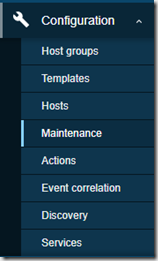
Cliquer Create Maintenance Period

Renseigner le nom de la période.
Intéressant, le choix est donné de collecter ou non les données.
Attention: les champs de date Active Since et Active Till ne représente pas la période de maintenance elle même mais le temps au sein duquel nous allons créer une ou plusieurs périodes dans l’onglet correspondant (Periods)
Dans l’exemple ci-dessous on positionne une plage de temps d’un an.
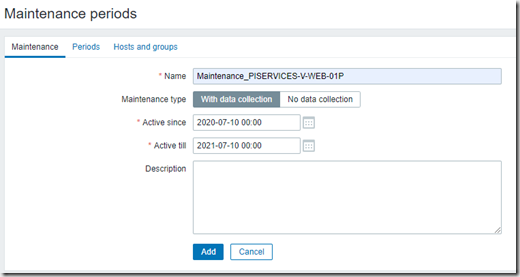
Aller dans l’onglet Periods. Cliquer Add

4 modes sont disponibles: One Time Only, Daily, Weekly et Monthly.
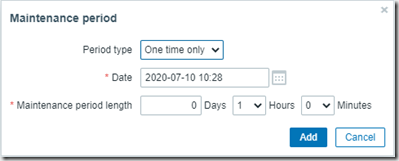
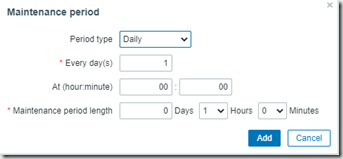
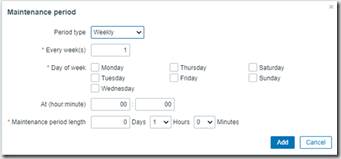
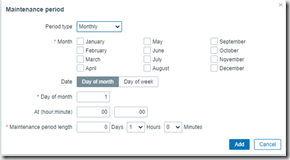
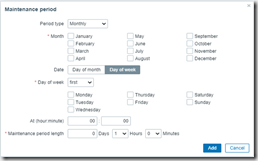
Dans l’onglet Hosts and groups, selectionner le/les hosts ou le/les host groups
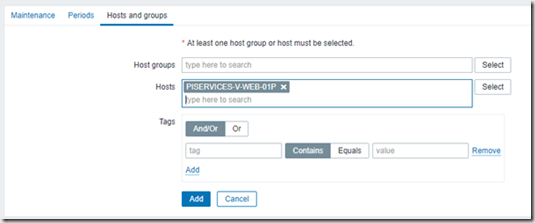
Une fois la période crée, elle apparait en état Approaching lorsque la date Active Since approche.

Lorsque les hosts concernés sont effectivement en période de maintenance, l’icone  apparait a coté, jusqu’a la fin de la période.
apparait a coté, jusqu’a la fin de la période.


Dans cet exemple, dans un an, la règle de maintenance passera en mode Expired.

Le script ci-dessous affiche tout les hosts avec leur status et les templates associés
GetZabbixAlIHostsAndTemplates(Native_API).ps1 (2,46 kb)
### GET ALL ZABBIX HOSTS WITH THEIR STATUS AND TEMPLATES LINKED
Param(
[Parameter(Mandatory=$false)] $baseurl='https://MyZabbixSrv.My.domain/zabbix',
$credential = (Get-Credential -Credential "MyAccount"),
)
$global:JsonParams = @{}
#
Function ConnectZabbix($cred,$baseurl)
{
$JsonParams.body = @{
"jsonrpc"= "2.0"
"method"= "user.login"
"params"= @{
"user"= $cred.UserName
"password"= $cred.GetNetworkCredential().Password
}
"id"= 1
"auth"= $null
} | ConvertTo-Json
$JsonParams.uri = "$baseurl/api_jsonrpc.php"
$JsonParams.headers = @{"Content-Type" = "application/json"}
$JsonParams.method = "Post"
[System.Net.ServicePointManager]::SecurityProtocol = 'tls12'
[Net.ServicePointManager]::ServerCertificateValidationCallback = {$true}
$global:Connresult = Invoke-WebRequest @JsonParams -UseBasicParsing
}
# Invoke ConnectZabbix
ConnectZabbix -cred $credential -baseurl $baseurl
## GET HOSTS ##
$JsonParams.body = @{
"jsonrpc"= "2.0"
"method"= "host.get"
"params"= @{
output = "hostid","name","available","status"
selectParentTemplates = "templateid","name"
}
auth = ($Connresult.Content | ConvertFrom-Json).result
id = 2
} | ConvertTo-Json
$ZabbixHosts = Invoke-WebRequest @JsonParams -UseBasicParsing
$ZabbixHosts = $ZabbixHosts.Content | ConvertFrom-Json
## CREATE EMPTY TABLEAU THAT WILL STORE HOSTS AND TEMPLATES
$HostsAndTemp = @()
foreach ($Zabbhost in $ZabbixHosts.result)
{
$obj = New-Object psobject
$obj | Add-Member -Name "HOSTNAME" -membertype Noteproperty -Value $Zabbhost.name
$obj | Add-Member -Name "ZBX AGENT STATUS" -membertype Noteproperty -Value `
$(
switch ($Zabbhost.status)
{
0 {"ENABLED"}
1 {"DISABLED"}
}
)
$obj | Add-Member -Name "ZBX AGENT AVAILABLE" -membertype Noteproperty -Value `
$(
switch ($Zabbhost.available)
{
1 {"AVAILABLE"}
2 {"UNAVAILABLE"}
0 {"UNKNOWN"}
}
)
$obj | Add-Member -Name "ZABBIX TEMPLATES LINKED" -membertype Noteproperty -Value $Zabbhost.parentTemplates.name
$HostsAndTemp += $obj
}
# TABLEAU FINAL
write-host "`n---- $($ZabbixHosts.result.Count) HOSTS ---`n"
write-host "HOSTNAME - ZBX AGENT STATUS - ZBX AGENT AVAILABLE - ZABBIX TEMPLATES LINKED`n"
$HostsAndTemp | sort hostname | ft -AutoSize
Zabbix propose plusieurs manière de superviser des URL. L’exemple ci-dessous propose d’utiliser un ‘Web Scenario’ pour la supervision d’une URL simple (ici www.google.fr).
on commence par créer un template vide qui contiendra la configuration:


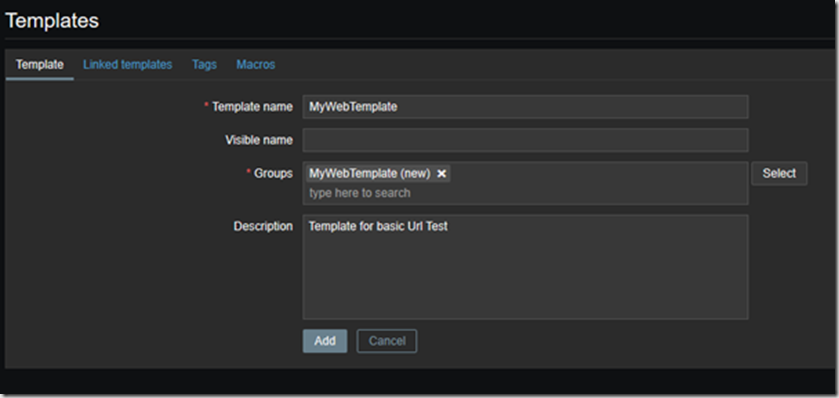
NB: Le nom du Host group associé est arbitraire.
Cliquer Add.

Le template vide est crée.

Cliquer “Create Web Scenario”
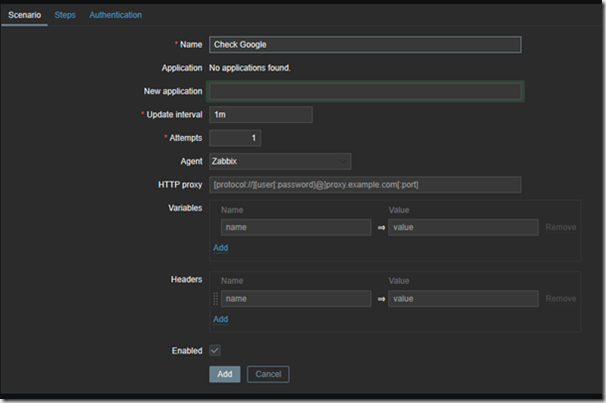
Name: Check Google
Agent: On positionne Zabbix. ce champs permet de selectionner plusieurs type de client http/navigateur.
Cliquer Steps.

Dans la zone Steps, cliquer sur Add.
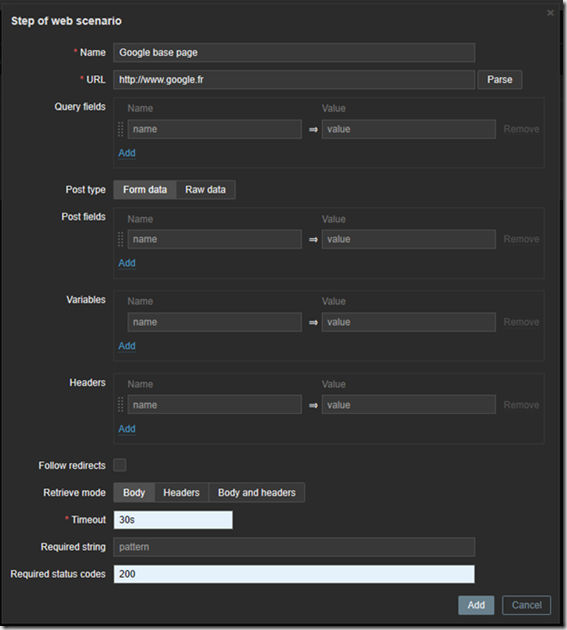
name: Google base page
URL: http://www.google.fr
Required Status codes: 200


Cliquer Add

Le Web scenario est crée.
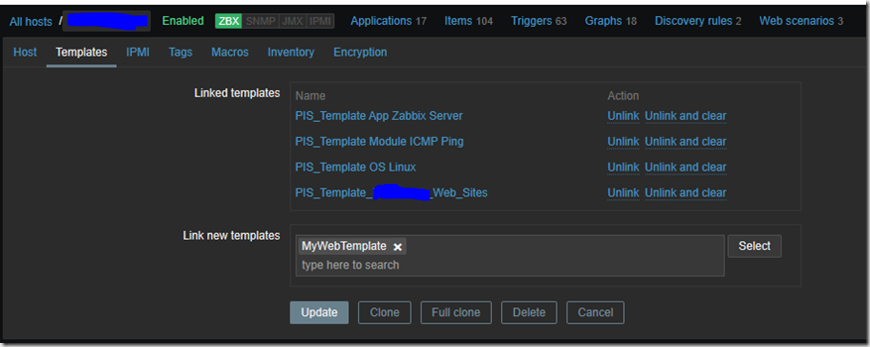
On applique (Link) le template au host devant effectuer le check de supervision.


Apres quelques minutes les données remonte dans la liste des “Latest data” du host concerné. on voit ici que le code HTTP renvoyé est bien 200 (OK)
On crée a présent un trigger (alerte) en charge declencher une alerte sur le cas ou le code HTTP serait different de 200.


Dans les propriétés du template, cliquer Triggers

cliquer en haut a droite Create Trigger
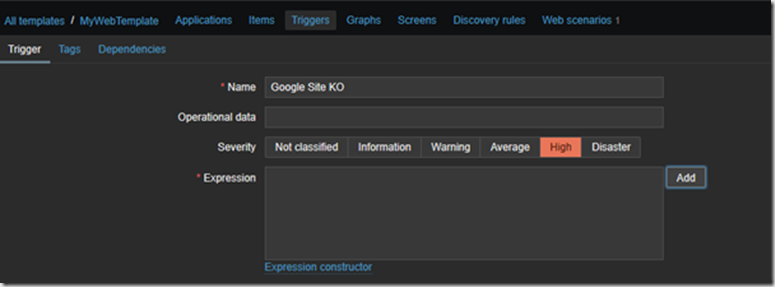
Name: Google Site KO
Clquer sur Add a coté de la zone Expression pour construire la condition de declenchement.

Cliquer sur Select pour aller rechercher l’item crée precedemment.
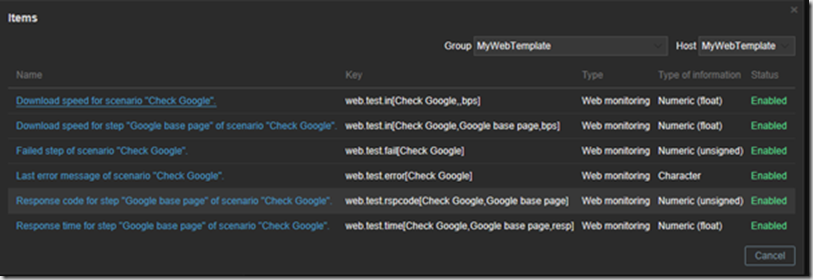
Selectionner “Response code for step “Google base page”…”

Laisser selectionné la fonction “last()”.
Result: <> 200
cliquer Insert.
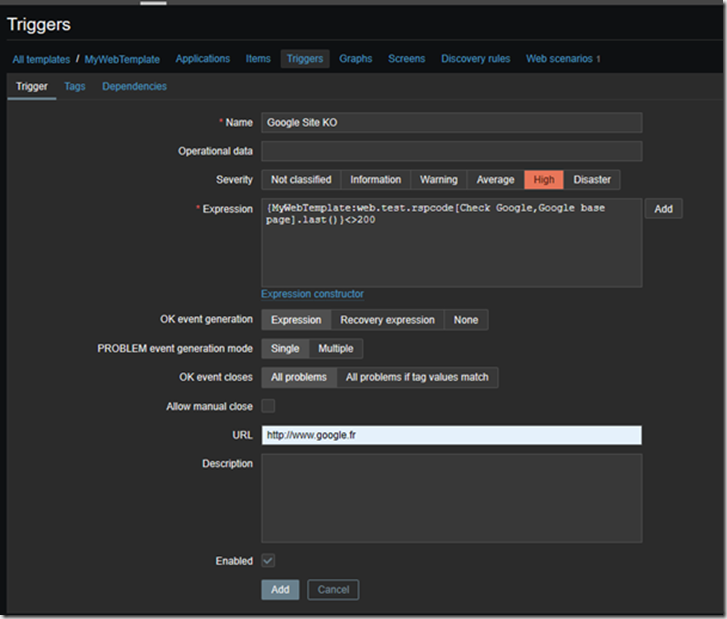
A titre d’indication ajouter le nom de l’url surveillée dans le champ URL.
Cliquer Add.

Le trigger est maintenant actif.
Le script suivant est une nouvelle version d'un script récemment proposé. Ont été rajouté le choix entre suppression et mode maintenance (on verifie aussi que la machine est déjà en mode maintenance)
DeleteOrMaintenanceAgentUponPropertyValue.ps1 (14,85 kb)
## DeleteOrMaintenanceAgentUponPropertyValue.ps1
## SCOM - REMOVE FROM CONSOLE OR PUT IN MAINTENANCE MODE, AGENT(S) THAT HAVE SPECIFIC VALUES IN ONE OR MORE CLASS PROPERTY.
## AUTHOR: C.JOURDAN
## Version: 1.1
## PARAMETERS
## $MS: Target Management Server
## $ObjectClass: Display Name of Target Class
## $FirstProperty: name of class property
## $FirstPropVal: multi value possible of $FirstProperty
## $Action: DELETE or MAINTENANCE
## $MaintenanceDuration: Nb of minutes for Maintenance Mode
## $ThreshNotDelete: Nb of found computers to delete over which we only warn (NO AUTOMATIC DELETE)
## NOTES: $ThreshNotDelete PARAMETER IS A SECURITY OPTION TO AVOID DELETION OF TWO MANY AGENTS. BE SURE OF THE APPLIED CRITERIAS BEFORE UNLOCK THAT!
#PARAMETERS
Param(
[Parameter(Mandatory=$false)]
$MGroup,
[Parameter(Mandatory=$false)]
$MS="MyMS",
[Parameter(Mandatory=$false)]
$ObjectClass="MyClass",
[Parameter(Mandatory=$false)]
$FirstProperty='MyProperty',
[Parameter(Mandatory=$false)]
$FirstPropVal="^.*(AZERTY|QWERTY).*$",
<# -- ADDITIONAL PROPERTIES FROM $ObjectClass INSTANCE -- SEE CLASS INSTANCE RETRIEVE SECTION
[Parameter(Mandatory=$false)]
$SecondProperty='Prop2',
[Parameter(Mandatory=$false)]
$SecondPropVal='Value2'
#>
[Parameter(Mandatory=$false)]
$Action = "Maintenance",
[Parameter(Mandatory=$false)]
$MaintenanceDuration = 30,
[Parameter(Mandatory=$false)]
$ThreshNotDelete = 10
)
#ScriptName
$ScriptName = "DeleteOrMaintenanceAgentUponPropertyValue.ps1"
#FUNCTIONS
# NewEventSource
# Check of a source existance in the 'operation manager' eventlog that match the script name, to log some events.
Function NewEventSource
{
if(!(Test-Path "HKLM:\SYSTEM\CurrentControlSet\services\eventlog\Operations Manager\$ScriptName"))
{
New-EventLog -LogName "Operations Manager" -Source $ScriptName
}
}
# DeleteSCOMAgent
# Remove agent from SCOM Console.
Function DeleteSCOMAgent
{
Param(
[string[]]$AgentComputerName,
[string]$MSServer
)
[System.Reflection.Assembly]::Load("Microsoft.EnterpriseManagement.Core, Version=7.0.5000.0, Culture=neutral, PublicKeyToken=31bf3856ad364e35")
[System.Reflection.Assembly]::Load("Microsoft.EnterpriseManagement.OperationsManager, Version=7.0.5000.0, Culture=neutral, PublicKeyToken=31bf3856ad364e35")
function New-Collection ( [type] $type )
{
$typeAssemblyName = $type.AssemblyQualifiedName;
$collection = new-object "System.Collections.ObjectModel.Collection``1[[$typeAssemblyName]]";
return ,($collection);
}
# Connect to management group
Write-output "Connecting to management group "$ConnectionSetting.name""
$ConnectionSetting = New-Object Microsoft.EnterpriseManagement.ManagementGroup($MSServer)
$admin = $ConnectionSetting.GetAdministration()
Write-output "Getting agent managed computers"
$agentManagedComputers = $admin.GetAllAgentManagedComputers()
# Get list of agents to delete
foreach ($name in $AgentComputerName)
{
Write-output "Checking for $name"
foreach ($agent in $agentManagedComputers)
{
if ($deleteCollection -eq $null)
{
$deleteCollection = new-collection $agent.GetType()
}
if (@($agent.PrincipalName -eq $name))
{
Write-output "Matched $name"
$deleteCollection.Add($agent)
break
}
}
}
if ($deleteCollection.Count -gt 0)
{
Write-output "Deleting agents"
$admin.DeleteAgentManagedComputers($deleteCollection)
if($?){
$Script:result="Agents deleted"
Write-Output $result
}
Else {
$result="Error during deletion of one ore more agent"
Write-Output $result
}
}
Else
{
$result="No Agent found to delete"
Write-Output $result
}
}
Function SetMM
{
# Function SetMM
########################################################################
#
#
[CmdletBinding()]
param(
[string]$HostToMM,
[string]$Duration
)
$startTime = [DateTime]::Now
$endTime = $startTime.AddMinutes($Duration)
# Get "Microsoft.Windows.Computer" Class
$Class = get-SCOMclass | where-object {$_.Name -eq "Microsoft.Windows.Computer"};
$Instance = Get-SCOMClassInstance -Class $Class | Where-Object {$_.Displayname -like "$HostToMM*"};
Start-SCOMMaintenanceMode -Instance $Instance -Reason "PlannedOther" -EndTime $endTime -Comment "PLANNED BY SCOM AGENT REMOVER" -ErrorAction Stop
}
#END FUNCTIONS
#Log of script execution
NewEventSource
$message = "Execution du script $ScriptName"
$message
write-eventlog -logname "Operations Manager" -Source $ScriptName -EventID 999 -Message $message -EntryType Information
# Check if $Action is valid
if ($Action -notmatch "^delete|maintenance$")
{
$message = "NO VALID ACTION HAS BEEN CHOOSED - POSSIBLE VALUE: `"DELETE`" OR `"MAINTENANCE`""
write-host -ForegroundColor Yellow $message
NewEventSource
write-eventlog -logname "Operations Manager" -Source $ScriptName -EventID 1000 -Message $message -EntryType Warning
exit 1
}
#Import of SCOM Powershell module
try
{
Import-Module -Name OperationsManager -ErrorAction stop
}
catch
{
$message = "ERROR DURING IMPORT OF SCOM PS MODULE"
write-host -ForegroundColor red $message
NewEventSource
write-eventlog -logname "Operations Manager" -Source $ScriptName -EventID 1001 -Message $message -EntryType Error
exit 1
}
#Connection to management group $MGroup
try
{
New-SCOMManagementGroupConnection -ComputerName $MS
}
catch
{
$message = "ERROR DURING CONNECTION TO $MS"
write-host -ForegroundColor red $message
NewEventSource
write-eventlog -logname "Operations Manager" -Source $ScriptName -EventID 1002 -Message $message -EntryType Error
exit 1
}
# Get $ObjectClass Class
$Class = Get-SCOMClass -displayname $ObjectClass | Where-Object {$_.PropertyCollection -match "^.*($FirstProperty|$SecondProperty).*$"} -ErrorAction stop ## -- WE CHECK THAT THE TARGET CLASS REALLY HOLD THE WANTED PROPERTIES
if (!($Class))
{
$message = "ERROR DURING RETRIEVE OF '$ObjectClass' CLASS. (CRITERIAS: Class=`"$ObjectClass`" - Property=`"$FirstProperty`" - Value=`"$FirstPropVal`")"
write-host -ForegroundColor red $message
NewEventSource
write-eventlog -logname "Operations Manager" -Source $ScriptName -EventID 1003 -Message $message -EntryType Error
exit 1
}
# Get Computers that have $FirstProperty value as: $FirstPropVal
try
{
$TargetComp = $Class | Get-SCOMClassInstance | Where-Object {
$_."[$($Class.Name)].$FirstProperty".value -match $FirstPropVal -OR $_.$FirstProperty -match $FirstPropVal` ##-- DIFFERENT COMBINATION (THE "[$($Class.Name)]" SYNTAX IS TO INCLUDE CASE OF A NOTE PROPERTY
#-AND $_."[$($Class.Name)].$SecondProperty".value -eq $SecondPropVal -OR $_.$SecondProperty -eq $SecondPropVal` ##-- ADDITIONAL POTENTIAL PROPERTIES (SEE SCRIPT PARAMS)
} -ErrorAction Stop
#$TargetComp = $Class | Get-SCOMClassInstance | Where-Object { ## -- TO TEST UNFOUND COMPUTER SCENARIO
#$_."[$($Class.Name)].$FirstProperty".value -eq "azerty" -OR $_.$FirstProperty -eq "azerty"` ## -- TO TEST UNFOUND COMPUTER SCENARIO
#} -ErrorAction Stop ## -- TO TEST UNFOUND COMPUTER SCENARIO
}
catch
{
$message = "ERROR DURING RETRIEVE OF CLASS INSTANCES (CRITERIAS: Class=`"$ObjectClass`" - Property=`"$FirstProperty`" - Value=`"$FirstPropVal`")"
write-host -ForegroundColor red $message
NewEventSource
write-eventlog -logname "Operations Manager" -Source $ScriptName -EventID 1004 -Message $message -EntryType Error
exit 1
}
switch($Action)
{
"Delete" {
# Analyse the content of $TargetComp
switch($TargetComp.Count)
{
{$_ -lt 1} {
$message = "NO AGENT TO REMOVE (CRITERIAS: Class=`"$ObjectClass`" - Property=`"$FirstProperty`" - Value=`"$FirstPropVal`")"
Write-Host -F Blue -B White $message
NewEventSource
write-eventlog -logname "Operations Manager" -Source $ScriptName -EventID 1005 -Message $message -EntryType Information
}
{$_ -ge 1 -AND $_ -le $ThreshNotDelete} ## -- SECURITY OPTION TO AVOID DELETION OF TWO MANY AGENTS. BE SURE OF THE APPLIED CRITERIAS BEFORE UNLOCK THAT!
{
$message = "FOLLOWING AGENTS WILL BE REMOVED:"
Write-Host -F Yellow $message
$TargetComp.displayname
DeleteSCOMAgent -AgentComputerName $TargetComp.displayname -MSServer $MS
#$result
switch($result)
{
"Agents deleted"
{
$message = "FOLLOWING AGENTS HAS BEEN REMOVED FROM SCOM CONSOLE (CRITERIAS: Class=`"$ObjectClass`" - Property=`"$FirstProperty`" - Value=`"$FirstPropVal`") :`n "
$message += $TargetComp | foreach {$_.DisplayName ;"`n"}
write-host $message
NewEventSource
write-eventlog -logname "Operations Manager" -Source $ScriptName -EventID 1006 -Message $message -EntryType Information
}
"Error during deletion of one ore more agent"
{
$message = "ERROR DURING DELETION OF ONE OR MORE AGENT! MANUAL CHECK REQUIRED (CRITERIAS: Class=`"$ObjectClass`" - Property=`"$FirstProperty`" - Value=`"$FirstPropVal`") "
write-host $message
NewEventSource
write-eventlog -logname "Operations Manager" -Source $ScriptName -EventID 1007 -Message $message -EntryType Warning
}
"No Agent found to delete"
{
$message = "NO AGENT FOUND TO DELETE - MANUAL CHECK REQUIRED (CRITERIAS: Class=`"$ObjectClass`" - Property=`"$FirstProperty`" - Value=`"$FirstPropVal`")"
write-host $message
NewEventSource
write-eventlog -logname "Operations Manager" -Source $ScriptName -EventID 1008 -Message $message -EntryType Warning
}
}
}
{$_ -gt $ThreshNotDelete} {
$message = "WARNING: NUMBER OF AGENTS TO REMOVE IS GREATER THAN 10 ! MANUAL CHECK REQUIRED" ## -- SECURITY OPTION TO AVOID DELETION OF TWO MANY AGENTS. BE SURE OF THE APPLIED CRITERIAS BEFORE UNLOCK THAT!
Write-Host -F red $message
$TargetComp.displayname
NewEventSource
write-eventlog -logname "Operations Manager" -Source $ScriptName -EventID 1009 -Message $message -EntryType Warning
}
}
}
"Maintenance" {
#Clear-Variable message
If ($TargetComp.Count -ge 1)
{
foreach ($target in $TargetComp)
{
If (Get-SCOMMaintenanceMode -Instance $target)
{
#$message += "`n$target IS ALREADY IN MAINTENANCE MODE"
$AlreadyInMM += "$target`n"
}
Else
{
SetMM -HostToMM $target -Duration $MaintenanceDuration
$PutInMM += "$target`n"
}
}
$message = "`nFOLLOWING AGENTS HAS BEEN SET IN MAINTENANCE MODE (CRITERIAS: Class=`"$ObjectClass`" - Property=`"$FirstProperty`" - Value=`"$FirstPropVal`") :`n"
$message += $PutInMM
$message += "`n`nFOLLOWING AGENTS ARE ALREADY IN MAINTENANCE MODE (CRITERIAS: Class=`"$ObjectClass`" - Property=`"$FirstProperty`" - Value=`"$FirstPropVal`") :`n"
$message += $AlreadyInMM
write-host $message
NewEventSource
write-eventlog -logname "Operations Manager" -Source $ScriptName -EventID 1010 -Message $message -EntryType Information
}
Else
{
$message = "NO AGENT TO PUT IN MAINTENANCE MODE HAS BEEN FOUND. (CRITERIAS: Class=`"$ObjectClass`" - Property=`"$FirstProperty`" - Value=`"$FirstPropVal`")"
write-host $message
NewEventSource
write-eventlog -logname "Operations Manager" -Source $ScriptName -EventID 1011 -Message $message -EntryType Information
}
}
default {
$message = "No action has been choosed. Possible value: `"Delete`" (Delete Agent from console) or `"Maintenance`" (Put corresponding computer in Maintenance Mode)"
write-host -ForegroundColor red $message
NewEventSource
write-eventlog -logname "Operations Manager" -Source $ScriptName -EventID 1012 -Message $message -EntryType Error
exit 1
}
}
Le script ci-dessous propose de comparer un extract des agents scom avec une liste de machine, pour un suivi de déploiement par exemple.
Compare_SCOMAgent_ComputerList.ps1 (1,67 kb)
### COMPARE SCOM AGENTS AND COMPUTER LIST IN TXT FILE
#Parameters
Param(
[Parameter(Mandatory=$false)]
$MS="MyMS.MyDomain",
[Parameter(Mandatory=$false)]
$Cred = $(Get-Credential "MyDomain\Me"),
[Parameter(Mandatory=$false)]
$FilePath = "C:\ServerList.txt "
)
#Import du module SCOM
try
{
Import-Module -Name OperationsManager -ErrorAction stop
}
catch
{
write-host -ForegroundColor red "Erreur lors de l'import du module SCOM"
}
#Connection au management group $MGroup
New-SCOMManagementGroupConnection -ComputerName $MS -Credential $Cred
# Recuperation de la liste des agents (netbios name
$agents = Get-SCOMAgent | select computername -ExpandProperty computername
# Import du fichier $FilePath
try
{
$ComputerList = Get-Content -Path $FilePath
}
catch
{
write-host -ForegroundColor red "Error during import of `"$FilePath`""
}
# Machines dans Scom ET dans la liste
$Both = $(Compare-Object -ReferenceObject $agents -DifferenceObject $ComputerList -IncludeEqual -ExcludeDifferent).inputobject
# Machines uniquement dans SCOM
$InScom = $(Compare-Object -ReferenceObject $agents -DifferenceObject $ComputerList | Where-Object {$_.sideindicator -eq "<="}).inputobject
# Machines uniquement dans la liste
$InFile = $(Compare-Object -ReferenceObject $agents -DifferenceObject $ComputerList | Where-Object {$_.sideindicator -eq "=>"}).inputobject
write-host -B White -F Blue "`n $($both.Count) COMPUTERS THAT ARE IN SCOM AND IN FILE:"
$Both
write-host -B White -F Blue "`n $($InScom.Count) COMPUTERS THAT ARE ONLY IN SCOM:"
$InScom
write-host -B White -F Blue "`n $($InList.Count) COMPUTERS THAT ARE ONLY IN FILE:"
$InFile
Le script ci-dessous propose le scenario ou l'on doit automatiser la suppression d'un agent de la console (pas une desinstallation) en fonction de la valeur d'une ou plusieurs propriétés de l'instance d'une classe pour ce/ces agents.
Ceci peut permettre par exemple dans la cas de la présence d'une classe étendue (avec vos propres propriétés issues par exemple d'un outil tiers) de decommissionner un ou plusieurs agents automatiquement, selon la valeur de ces propriétés (Dans l'exemple inscrit par defaut dans les paramètres, on cherche la valeur 'Useless' ou 'Deprecated' de la propriété 'Usage' de la classe 'MyClass')
RemoveAgentUponPropertyVal.ps1 (10,67 kb)
## RemoveAgentUponPropertyVal.ps1
## SCOM - REMOVE AGENT(S) FROM CONSOLE THAT HAVE SPECIFIC VALUES IN ONE OR MORE CLASS PROPERTY.
## AUTHOR: C.JOURDAN
## Version: 1.0
## PARAMETERS
## $MS: Target Management Server
## $ObjectClass: Display Name of Target Class
## $FirstProperty: name of class property
## $FirstPropVal: multi value possible of $FirstProperty
## $ThreshNotDelete: Nb of found computers to delete over which we only warn (NO AUTOMATIC DELETE)
## NOTES: $ThreshNotDelete PARAMETER IS A SECURITY OPTION TO AVOID DELETION OF TWO MANY AGENTS. BE SURE OF THE APPLIED CRITERIAS BEFORE UNLOCK THAT!
#PARAMETERS
Param(
[Parameter(Mandatory=$false)]
$MGroup,
[Parameter(Mandatory=$false)]
$MS='localhost',
[Parameter(Mandatory=$false)]
$ObjectClass = 'MyClass',
[Parameter(Mandatory=$false)]
$FirstProperty='Usage',
[Parameter(Mandatory=$false)]
$FirstPropVal="^.*(Useless|Deprecated).*$",
<# -- ADDITIONAL PROPERTIES FROM $ObjectClass INSTANCE -- SEE CLASS INSTANCE RETRIEVE SECTION
[Parameter(Mandatory=$false)]
$SecondProperty='Prop2',
[Parameter(Mandatory=$false)]
$SecondPropVal='Value2'
#>
[Parameter(Mandatory=$false)]
$ThreshNotDelete = 10
)
#ScriptName
$ScriptName = "RemoveAgentUponPropertyVal.ps1"
#FUNCTIONS
# NewEventSource
# Check of a source existance in the 'operation manager' eventlog that match the script name, to log some events.
Function NewEventSource
{
if(!(Test-Path "HKLM:\SYSTEM\CurrentControlSet\services\eventlog\Operations Manager\$ScriptName"))
{
New-EventLog -LogName "Operations Manager" -Source $ScriptName
}
}
# DeleteSCOMAgent
# Remove agent from SCOM Console.
Function DeleteSCOMAgent
{
Param(
[string[]]$AgentComputerName,
[string]$MSServer
)
[System.Reflection.Assembly]::Load("Microsoft.EnterpriseManagement.Core, Version=7.0.5000.0, Culture=neutral, PublicKeyToken=31bf3856ad364e35")
[System.Reflection.Assembly]::Load("Microsoft.EnterpriseManagement.OperationsManager, Version=7.0.5000.0, Culture=neutral, PublicKeyToken=31bf3856ad364e35")
function New-Collection ( [type] $type )
{
$typeAssemblyName = $type.AssemblyQualifiedName;
$collection = new-object "System.Collections.ObjectModel.Collection``1[[$typeAssemblyName]]";
return ,($collection);
}
# Connect to management group
Write-output "Connecting to management group"
$ConnectionSetting = New-Object Microsoft.EnterpriseManagement.ManagementGroup($MSServer)
$admin = $ConnectionSetting.GetAdministration()
Write-output "Getting agent managed computers"
$agentManagedComputers = $admin.GetAllAgentManagedComputers()
# Get list of agents to delete
foreach ($name in $AgentComputerName)
{
Write-output "Checking for $name"
foreach ($agent in $agentManagedComputers)
{
if ($deleteCollection -eq $null)
{
$deleteCollection = new-collection $agent.GetType()
}
if (@($agent.PrincipalName -eq $name))
{
Write-output "Matched $name"
$deleteCollection.Add($agent)
break
}
}
}
if ($deleteCollection.Count -gt 0)
{
Write-output "Deleting agents"
$admin.DeleteAgentManagedComputers($deleteCollection)
if($?){
$Script:result="Agents deleted"
Write-Output $result
}
Else {
$result="Error during deletion of one ore more agent"
Write-Output $result
}
}
Else
{
$result="No Agent found to delete"
Write-Output $result
}
}
#END FUNCTIONS
#Log of script execution
NewEventSource
write-eventlog -logname "Operations Manager" -Source $ScriptName -EventID 1000 -Message "Execution du script $ScriptName" -EntryType Information
#Import of SCOM Powershell module
try
{
Import-Module -Name OperationsManager -ErrorAction stop
}
catch
{
write-host -ForegroundColor red "Error during import of SCOM PS Module"
NewEventSource
write-eventlog -logname "Operations Manager" -Source $ScriptName -EventID 1001 -Message "Error during import of SCOM PS Module" -EntryType Error
exit 1
}
#Connection to management group $MGroup
try
{
New-SCOMManagementGroupConnection -ComputerName $MS
}
catch
{
write-host -ForegroundColor red "Error during connection to MS $MS"
NewEventSource
write-eventlog -logname "Operations Manager" -Source $ScriptName -EventID 1002 -Message "Error during connection to MS $MS" -EntryType Error
exit 1
}
# Get $ObjectClass Class
$Class = Get-SCOMClass -displayname $ObjectClass | Where-Object {$_.PropertyCollection -match "^.*($FirstProperty|$SecondProperty).*$"} -ErrorAction stop ## -- WE CHECK THAT THE TARGET CLASS REALLY HOLD THE WANTED PROPERTIES
if (!($Class))
{
$message = "ERROR DURING RETRIEVE OF '$ObjectClass' CLASS. CHECK THAT CLASS EXIST OR THAT THE PROPERTIES YOU WANT EXIST IN THIS CLASS"
write-host -ForegroundColor red $message
NewEventSource
write-eventlog -logname "Operations Manager" -Source $ScriptName -EventID 1003 -Message $message -EntryType Error
exit 1
}
# Get Computers that have $FirstProperty value as: $FirstPropVal
try
{
$TargetComp = $Class | Get-SCOMClassInstance | Where-Object {
$_."[$($Class.Name)].$FirstProperty".value -match $FirstPropVal -OR $_.$FirstProperty -match $FirstPropVal` ##-- DIFFERENT COMBINATION (THE "[$($Class.Name)]" SYNTAX IS TO INCLUDE CASE OF A NOTE PROPERTY
#-AND $_."[$($Class.Name)].$SecondProperty".value -eq $SecondPropVal -OR $_.$SecondProperty -eq $SecondPropVal` ##-- ADDITIONAL POTENTIAL PROPERTIES (SEE SCRIPT PARAMS)
} -ErrorAction Stop
#$TargetComp = $Class | Get-SCOMClassInstance | Where-Object { ## -- TO TEST UNFOUND COMPUTER SCENARIO
#$_."[$($Class.Name)].$FirstProperty".value -eq "azerty" -OR $_.$FirstProperty -eq "azerty"` ## -- TO TEST UNFOUND COMPUTER SCENARIO
#} -ErrorAction Stop ## -- TO TEST UNFOUND COMPUTER SCENARIO
}
catch
{
$message = "Error during retrieve of '$ObjectClass' instances that have $FirstProperty : $FirstPropVal"
write-host -ForegroundColor red $message
NewEventSource
write-eventlog -logname "Operations Manager" -Source $ScriptName -EventID 1004 -Message $message -EntryType Error
exit 1
}
# Analyse the content of $TargetComp
switch($TargetComp.Count)
{
{$_ -lt 1} {
$message = "NO AGENT TO REMOVE"
Write-Host -F Blue -B White $message
NewEventSource
write-eventlog -logname "Operations Manager" -Source $ScriptName -EventID 1005 -Message $message -EntryType Information
}
{$_ -ge 1 -AND $_ -le $ThreshNotDelete} ## -- SECURITY OPTION TO AVOID DELETION OF TWO MANY AGENTS. BE SURE OF THE APPLIED CRITERIAS BEFORE UNLOCK THAT!
{
$message = "FOLLOWING AGENTS WILL BE REMOVED:"
Write-Host -F Yellow $message
$TargetComp.displayname
DeleteSCOMAgent -AgentComputerName $TargetComp.displayname -MSServer $MS
#$result
switch($result)
{
"Agents deleted"
{
$message = "FOLLOWING AGENTS HAS BEEN REMOVED FROM SCOM CONSOLE SINCE THEIR $FirstProperty IS EQUAL: $FirstPropVal . $($TargetComp.displayname)"
NewEventSource
write-eventlog -logname "Operations Manager" -Source $ScriptName -EventID 1006 -Message $message -EntryType Information
}
"Error during deletion of one ore more agent"
{
$message = "ERROR DURING DELETION OF ONE OR MORE AGENT! MANUAL CHECK REQUIRED"
NewEventSource
write-eventlog -logname "Operations Manager" -Source $ScriptName -EventID 1007 -Message $message -EntryType Warning
}
"No Agent found to delete"
{
$message = "NO AGENT FOUND TO DELETE BY DeleteSCOMAgent FUNCTION! MANUAL CHECK REQUIRED"
NewEventSource
write-eventlog -logname "Operations Manager" -Source $ScriptName -EventID 1008 -Message $message -EntryType Warning
}
}
}
{$_ -gt $ThreshNotDelete} {
$message = "WARNING: NUMBER OF AGENTS TO REMOVE IS GREATER THAN 10 ! MANUAL CHECK REQUIRED" ## -- SECURITY OPTION TO AVOID DELETION OF TWO MANY AGENTS. BE SURE OF THE APPLIED CRITERIAS BEFORE UNLOCK THAT!
Write-Host -F red $message
$TargetComp.displayname
NewEventSource
write-eventlog -logname "Operations Manager" -Source $ScriptName -EventID 1009 -Message $message -EntryType Warning
}
}
Ci-dessous, un script bash de sauvegarde complète de la base Zabbix.
BackupZabbixDBFull.sh (1,17 kb)
#! /bin/bash
#Def de variables
user="<user>" #Utilisateur de la base de donnees
passwd="<password>" #Mot de passe de l'utilisateur de la base
db="zabbixdb" #Nom de la base
dest="/etc/backup/mysql-full-backup" #Chemin de destination de la sauvegarde (Attention, pas de slash a la fin)
nbsav=5 #Nombre de sauvegardes a conserver
#On fabrique les variables systeme
dte=$(date +"%Y-%m-%d--%H-%M-%S")
fic="$db/$db-$dte.sql"
#### SCRIPT ####
if [ -d $dest/$db ]
then
echo "On sauvegarde dans $db"
else
echo "On cree le dossier de sauvegarde $dest/$db"
mkdir $dest/$db
fi
echo "sauvegarde de la base $db dans $dest/$fic"
ionice -c3 nice -n19 mysqldump -u $user -p$passwd $db > "$dest/$fic"
echo "On compresse "$dest/$fic" avec gzip : $fic.gz"
ionice -c3 nice -n19 gzip "$dest/$fic"
nbfic=$(ls -C1X $dest/$db/$db* | wc -l)
diff=$(echo $(($nbfic-$nbsav)))
echo "On calcule le nombre de fichiers a supprimer pour ne garder que les $nbsav derniers : $diff"
i=1 #Compteur du for
for f in $(ls -C1X "$dest/$db")
do
if [ $i -le $diff ]
then
oldsav="$dest/$db/$f"
echo "On supprime $dest/$db/$f"
rm -f "$dest/$db/$f"
let i++
fi
done